Environmental Health - PDF
VerifiedAdded on 2021/05/31
|11
|3110
|303
AI Summary
Contribute Materials
Your contribution can guide someone’s learning journey. Share your
documents today.
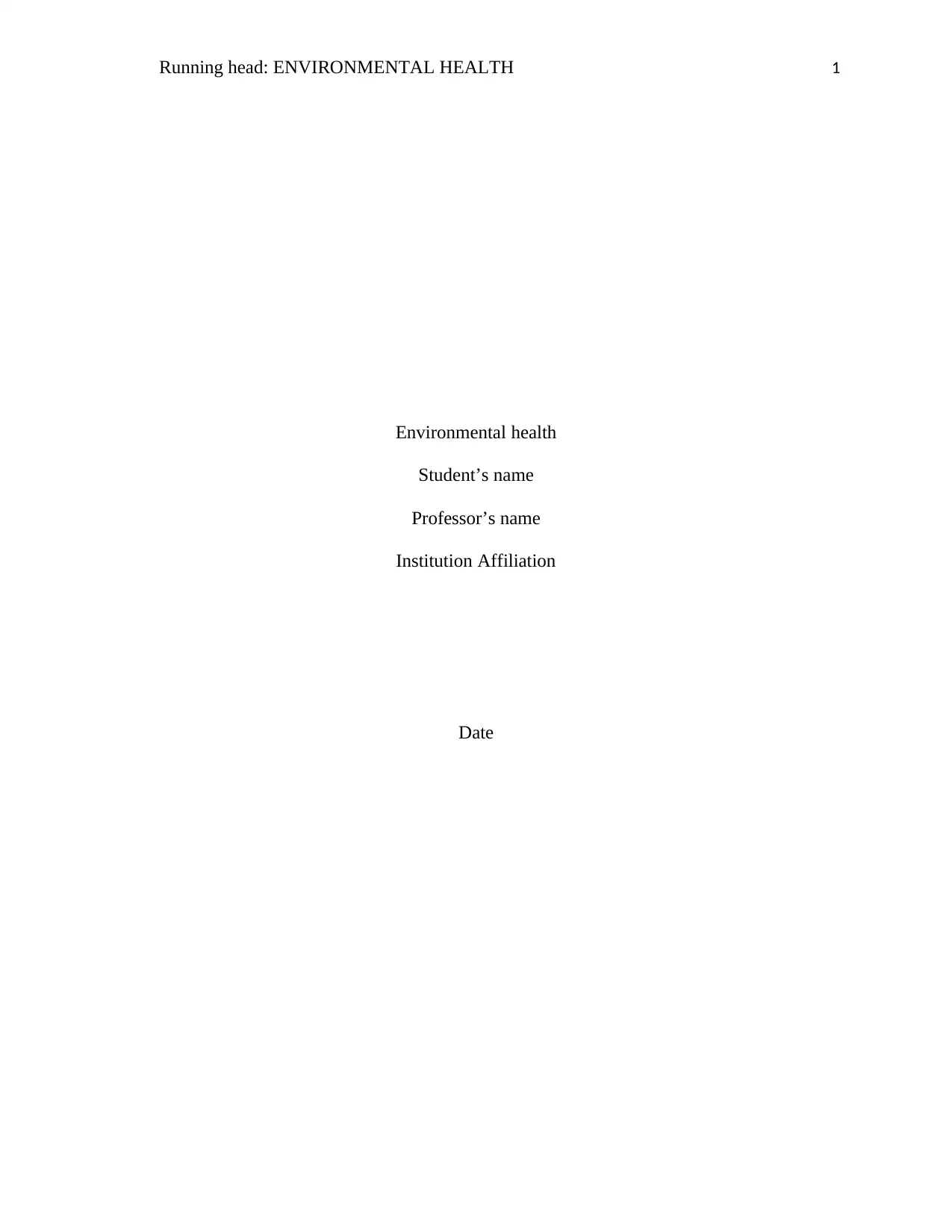
Running head: ENVIRONMENTAL HEALTH 1
Environmental health
Student’s name
Professor’s name
Institution Affiliation
Date
Environmental health
Student’s name
Professor’s name
Institution Affiliation
Date
Secure Best Marks with AI Grader
Need help grading? Try our AI Grader for instant feedback on your assignments.
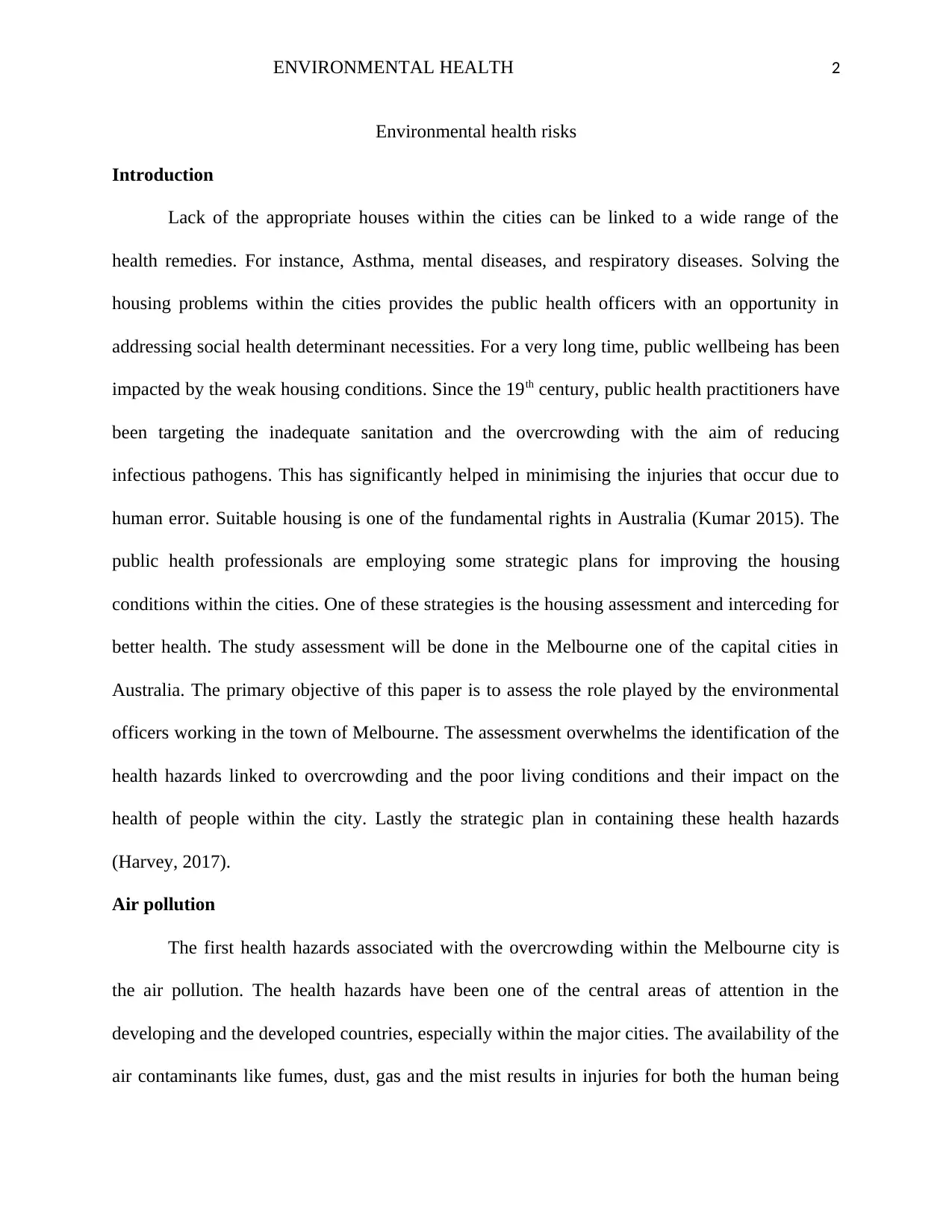
ENVIRONMENTAL HEALTH 2
Environmental health risks
Introduction
Lack of the appropriate houses within the cities can be linked to a wide range of the
health remedies. For instance, Asthma, mental diseases, and respiratory diseases. Solving the
housing problems within the cities provides the public health officers with an opportunity in
addressing social health determinant necessities. For a very long time, public wellbeing has been
impacted by the weak housing conditions. Since the 19th century, public health practitioners have
been targeting the inadequate sanitation and the overcrowding with the aim of reducing
infectious pathogens. This has significantly helped in minimising the injuries that occur due to
human error. Suitable housing is one of the fundamental rights in Australia (Kumar 2015). The
public health professionals are employing some strategic plans for improving the housing
conditions within the cities. One of these strategies is the housing assessment and interceding for
better health. The study assessment will be done in the Melbourne one of the capital cities in
Australia. The primary objective of this paper is to assess the role played by the environmental
officers working in the town of Melbourne. The assessment overwhelms the identification of the
health hazards linked to overcrowding and the poor living conditions and their impact on the
health of people within the city. Lastly the strategic plan in containing these health hazards
(Harvey, 2017).
Air pollution
The first health hazards associated with the overcrowding within the Melbourne city is
the air pollution. The health hazards have been one of the central areas of attention in the
developing and the developed countries, especially within the major cities. The availability of the
air contaminants like fumes, dust, gas and the mist results in injuries for both the human being
Environmental health risks
Introduction
Lack of the appropriate houses within the cities can be linked to a wide range of the
health remedies. For instance, Asthma, mental diseases, and respiratory diseases. Solving the
housing problems within the cities provides the public health officers with an opportunity in
addressing social health determinant necessities. For a very long time, public wellbeing has been
impacted by the weak housing conditions. Since the 19th century, public health practitioners have
been targeting the inadequate sanitation and the overcrowding with the aim of reducing
infectious pathogens. This has significantly helped in minimising the injuries that occur due to
human error. Suitable housing is one of the fundamental rights in Australia (Kumar 2015). The
public health professionals are employing some strategic plans for improving the housing
conditions within the cities. One of these strategies is the housing assessment and interceding for
better health. The study assessment will be done in the Melbourne one of the capital cities in
Australia. The primary objective of this paper is to assess the role played by the environmental
officers working in the town of Melbourne. The assessment overwhelms the identification of the
health hazards linked to overcrowding and the poor living conditions and their impact on the
health of people within the city. Lastly the strategic plan in containing these health hazards
(Harvey, 2017).
Air pollution
The first health hazards associated with the overcrowding within the Melbourne city is
the air pollution. The health hazards have been one of the central areas of attention in the
developing and the developed countries, especially within the major cities. The availability of the
air contaminants like fumes, dust, gas and the mist results in injuries for both the human being
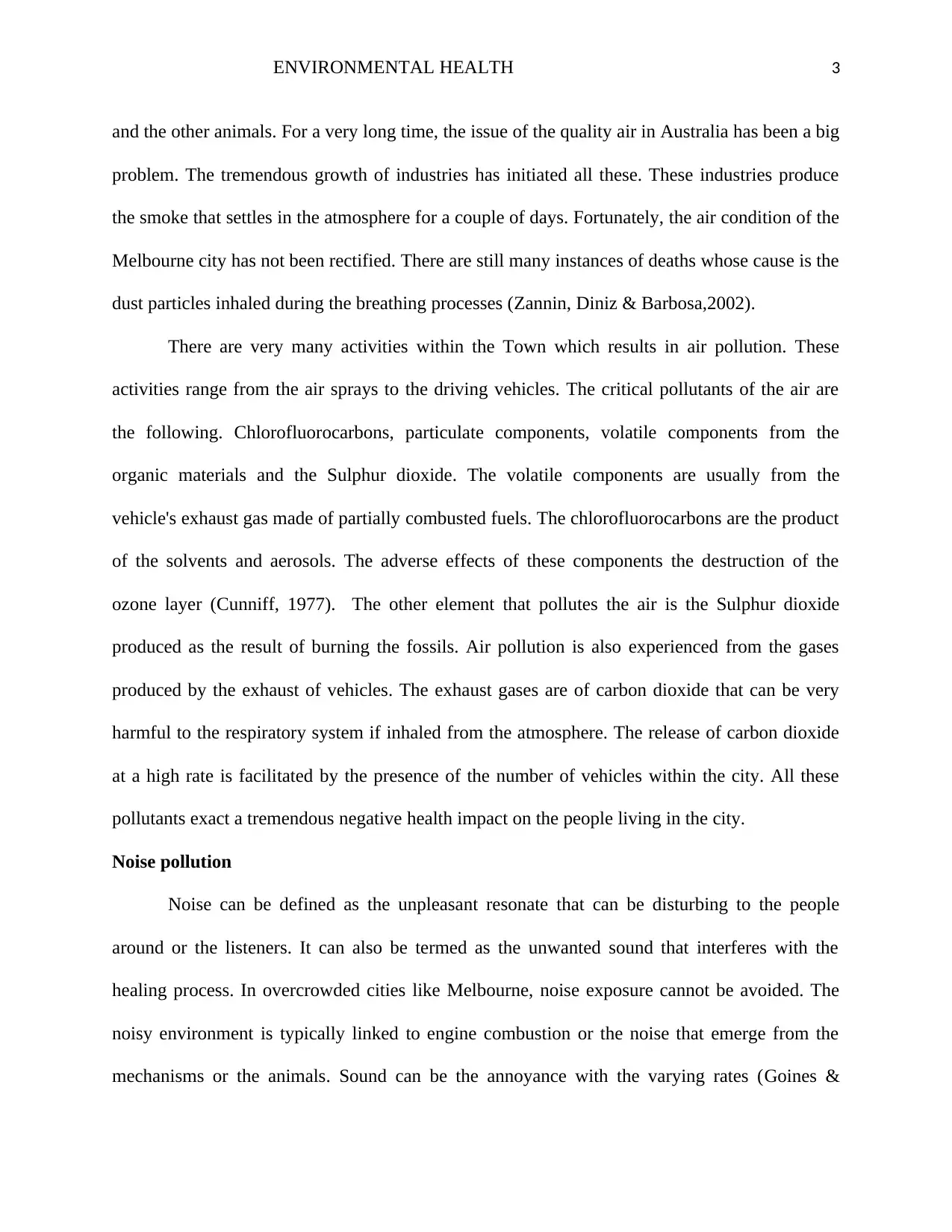
ENVIRONMENTAL HEALTH 3
and the other animals. For a very long time, the issue of the quality air in Australia has been a big
problem. The tremendous growth of industries has initiated all these. These industries produce
the smoke that settles in the atmosphere for a couple of days. Fortunately, the air condition of the
Melbourne city has not been rectified. There are still many instances of deaths whose cause is the
dust particles inhaled during the breathing processes (Zannin, Diniz & Barbosa,2002).
There are very many activities within the Town which results in air pollution. These
activities range from the air sprays to the driving vehicles. The critical pollutants of the air are
the following. Chlorofluorocarbons, particulate components, volatile components from the
organic materials and the Sulphur dioxide. The volatile components are usually from the
vehicle's exhaust gas made of partially combusted fuels. The chlorofluorocarbons are the product
of the solvents and aerosols. The adverse effects of these components the destruction of the
ozone layer (Cunniff, 1977). The other element that pollutes the air is the Sulphur dioxide
produced as the result of burning the fossils. Air pollution is also experienced from the gases
produced by the exhaust of vehicles. The exhaust gases are of carbon dioxide that can be very
harmful to the respiratory system if inhaled from the atmosphere. The release of carbon dioxide
at a high rate is facilitated by the presence of the number of vehicles within the city. All these
pollutants exact a tremendous negative health impact on the people living in the city.
Noise pollution
Noise can be defined as the unpleasant resonate that can be disturbing to the people
around or the listeners. It can also be termed as the unwanted sound that interferes with the
healing process. In overcrowded cities like Melbourne, noise exposure cannot be avoided. The
noisy environment is typically linked to engine combustion or the noise that emerge from the
mechanisms or the animals. Sound can be the annoyance with the varying rates (Goines &
and the other animals. For a very long time, the issue of the quality air in Australia has been a big
problem. The tremendous growth of industries has initiated all these. These industries produce
the smoke that settles in the atmosphere for a couple of days. Fortunately, the air condition of the
Melbourne city has not been rectified. There are still many instances of deaths whose cause is the
dust particles inhaled during the breathing processes (Zannin, Diniz & Barbosa,2002).
There are very many activities within the Town which results in air pollution. These
activities range from the air sprays to the driving vehicles. The critical pollutants of the air are
the following. Chlorofluorocarbons, particulate components, volatile components from the
organic materials and the Sulphur dioxide. The volatile components are usually from the
vehicle's exhaust gas made of partially combusted fuels. The chlorofluorocarbons are the product
of the solvents and aerosols. The adverse effects of these components the destruction of the
ozone layer (Cunniff, 1977). The other element that pollutes the air is the Sulphur dioxide
produced as the result of burning the fossils. Air pollution is also experienced from the gases
produced by the exhaust of vehicles. The exhaust gases are of carbon dioxide that can be very
harmful to the respiratory system if inhaled from the atmosphere. The release of carbon dioxide
at a high rate is facilitated by the presence of the number of vehicles within the city. All these
pollutants exact a tremendous negative health impact on the people living in the city.
Noise pollution
Noise can be defined as the unpleasant resonate that can be disturbing to the people
around or the listeners. It can also be termed as the unwanted sound that interferes with the
healing process. In overcrowded cities like Melbourne, noise exposure cannot be avoided. The
noisy environment is typically linked to engine combustion or the noise that emerge from the
mechanisms or the animals. Sound can be the annoyance with the varying rates (Goines &
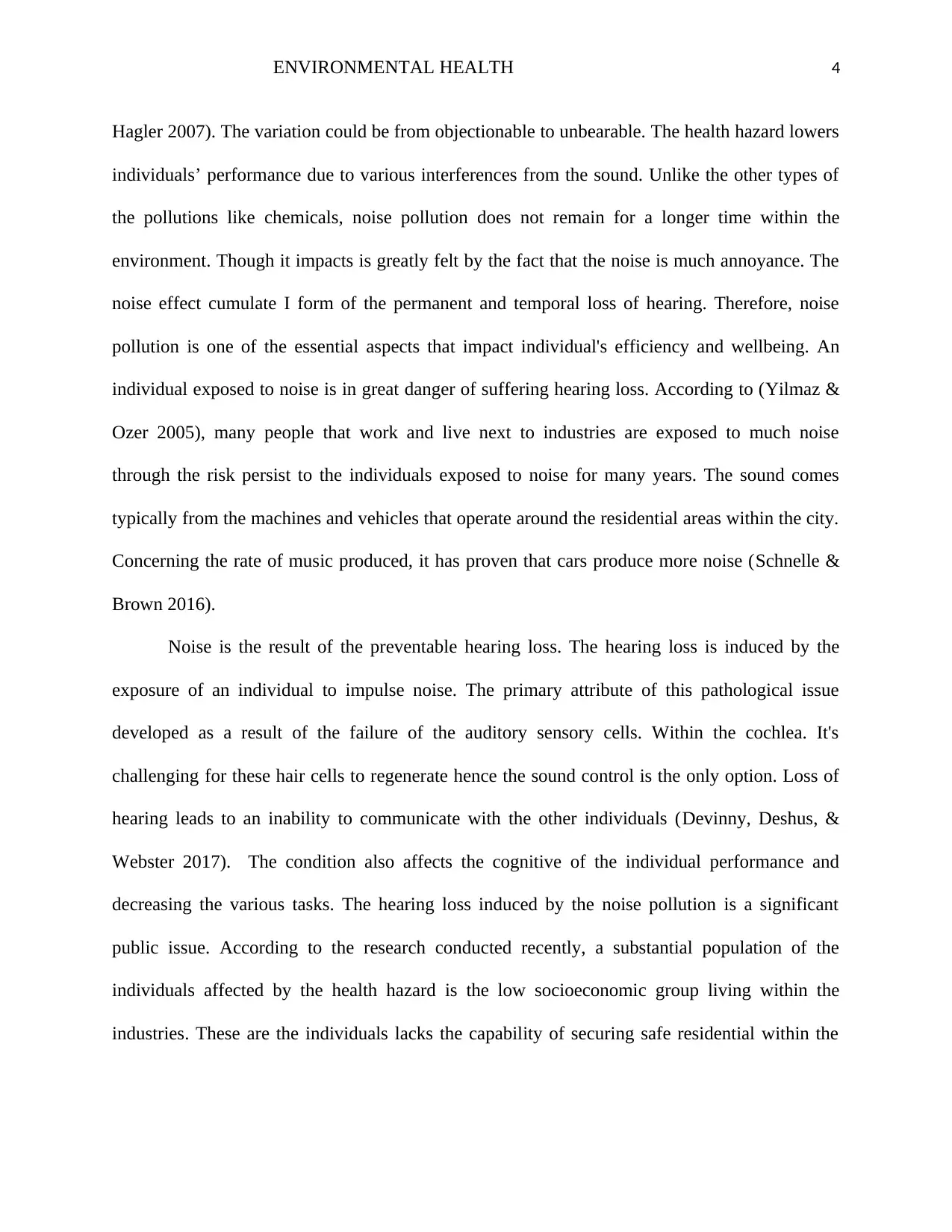
ENVIRONMENTAL HEALTH 4
Hagler 2007). The variation could be from objectionable to unbearable. The health hazard lowers
individuals’ performance due to various interferences from the sound. Unlike the other types of
the pollutions like chemicals, noise pollution does not remain for a longer time within the
environment. Though it impacts is greatly felt by the fact that the noise is much annoyance. The
noise effect cumulate I form of the permanent and temporal loss of hearing. Therefore, noise
pollution is one of the essential aspects that impact individual's efficiency and wellbeing. An
individual exposed to noise is in great danger of suffering hearing loss. According to (Yilmaz &
Ozer 2005), many people that work and live next to industries are exposed to much noise
through the risk persist to the individuals exposed to noise for many years. The sound comes
typically from the machines and vehicles that operate around the residential areas within the city.
Concerning the rate of music produced, it has proven that cars produce more noise (Schnelle &
Brown 2016).
Noise is the result of the preventable hearing loss. The hearing loss is induced by the
exposure of an individual to impulse noise. The primary attribute of this pathological issue
developed as a result of the failure of the auditory sensory cells. Within the cochlea. It's
challenging for these hair cells to regenerate hence the sound control is the only option. Loss of
hearing leads to an inability to communicate with the other individuals (Devinny, Deshus, &
Webster 2017). The condition also affects the cognitive of the individual performance and
decreasing the various tasks. The hearing loss induced by the noise pollution is a significant
public issue. According to the research conducted recently, a substantial population of the
individuals affected by the health hazard is the low socioeconomic group living within the
industries. These are the individuals lacks the capability of securing safe residential within the
Hagler 2007). The variation could be from objectionable to unbearable. The health hazard lowers
individuals’ performance due to various interferences from the sound. Unlike the other types of
the pollutions like chemicals, noise pollution does not remain for a longer time within the
environment. Though it impacts is greatly felt by the fact that the noise is much annoyance. The
noise effect cumulate I form of the permanent and temporal loss of hearing. Therefore, noise
pollution is one of the essential aspects that impact individual's efficiency and wellbeing. An
individual exposed to noise is in great danger of suffering hearing loss. According to (Yilmaz &
Ozer 2005), many people that work and live next to industries are exposed to much noise
through the risk persist to the individuals exposed to noise for many years. The sound comes
typically from the machines and vehicles that operate around the residential areas within the city.
Concerning the rate of music produced, it has proven that cars produce more noise (Schnelle &
Brown 2016).
Noise is the result of the preventable hearing loss. The hearing loss is induced by the
exposure of an individual to impulse noise. The primary attribute of this pathological issue
developed as a result of the failure of the auditory sensory cells. Within the cochlea. It's
challenging for these hair cells to regenerate hence the sound control is the only option. Loss of
hearing leads to an inability to communicate with the other individuals (Devinny, Deshus, &
Webster 2017). The condition also affects the cognitive of the individual performance and
decreasing the various tasks. The hearing loss induced by the noise pollution is a significant
public issue. According to the research conducted recently, a substantial population of the
individuals affected by the health hazard is the low socioeconomic group living within the
industries. These are the individuals lacks the capability of securing safe residential within the
Secure Best Marks with AI Grader
Need help grading? Try our AI Grader for instant feedback on your assignments.
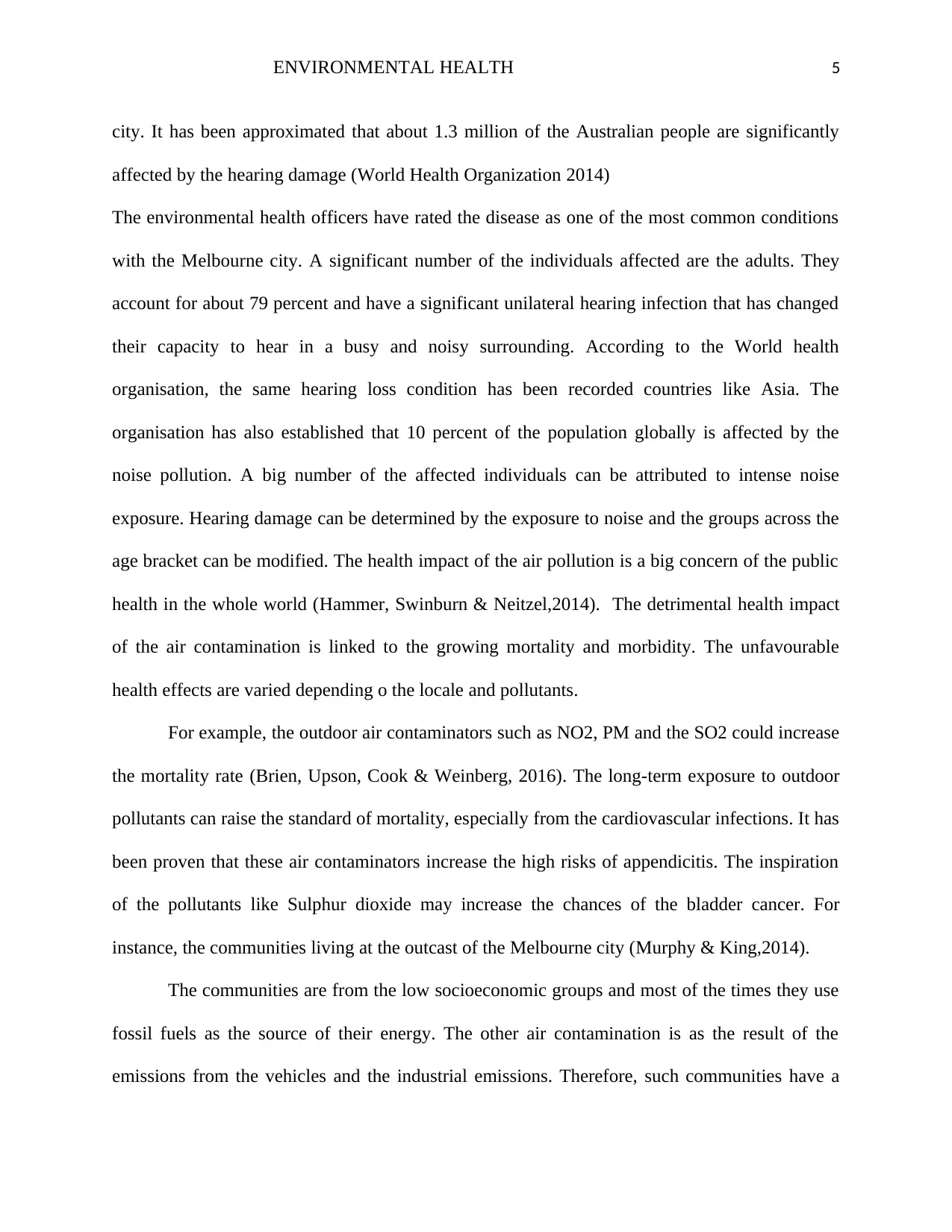
ENVIRONMENTAL HEALTH 5
city. It has been approximated that about 1.3 million of the Australian people are significantly
affected by the hearing damage (World Health Organization 2014)
The environmental health officers have rated the disease as one of the most common conditions
with the Melbourne city. A significant number of the individuals affected are the adults. They
account for about 79 percent and have a significant unilateral hearing infection that has changed
their capacity to hear in a busy and noisy surrounding. According to the World health
organisation, the same hearing loss condition has been recorded countries like Asia. The
organisation has also established that 10 percent of the population globally is affected by the
noise pollution. A big number of the affected individuals can be attributed to intense noise
exposure. Hearing damage can be determined by the exposure to noise and the groups across the
age bracket can be modified. The health impact of the air pollution is a big concern of the public
health in the whole world (Hammer, Swinburn & Neitzel,2014). The detrimental health impact
of the air contamination is linked to the growing mortality and morbidity. The unfavourable
health effects are varied depending o the locale and pollutants.
For example, the outdoor air contaminators such as NO2, PM and the SO2 could increase
the mortality rate (Brien, Upson, Cook & Weinberg, 2016). The long-term exposure to outdoor
pollutants can raise the standard of mortality, especially from the cardiovascular infections. It has
been proven that these air contaminators increase the high risks of appendicitis. The inspiration
of the pollutants like Sulphur dioxide may increase the chances of the bladder cancer. For
instance, the communities living at the outcast of the Melbourne city (Murphy & King,2014).
The communities are from the low socioeconomic groups and most of the times they use
fossil fuels as the source of their energy. The other air contamination is as the result of the
emissions from the vehicles and the industrial emissions. Therefore, such communities have a
city. It has been approximated that about 1.3 million of the Australian people are significantly
affected by the hearing damage (World Health Organization 2014)
The environmental health officers have rated the disease as one of the most common conditions
with the Melbourne city. A significant number of the individuals affected are the adults. They
account for about 79 percent and have a significant unilateral hearing infection that has changed
their capacity to hear in a busy and noisy surrounding. According to the World health
organisation, the same hearing loss condition has been recorded countries like Asia. The
organisation has also established that 10 percent of the population globally is affected by the
noise pollution. A big number of the affected individuals can be attributed to intense noise
exposure. Hearing damage can be determined by the exposure to noise and the groups across the
age bracket can be modified. The health impact of the air pollution is a big concern of the public
health in the whole world (Hammer, Swinburn & Neitzel,2014). The detrimental health impact
of the air contamination is linked to the growing mortality and morbidity. The unfavourable
health effects are varied depending o the locale and pollutants.
For example, the outdoor air contaminators such as NO2, PM and the SO2 could increase
the mortality rate (Brien, Upson, Cook & Weinberg, 2016). The long-term exposure to outdoor
pollutants can raise the standard of mortality, especially from the cardiovascular infections. It has
been proven that these air contaminators increase the high risks of appendicitis. The inspiration
of the pollutants like Sulphur dioxide may increase the chances of the bladder cancer. For
instance, the communities living at the outcast of the Melbourne city (Murphy & King,2014).
The communities are from the low socioeconomic groups and most of the times they use
fossil fuels as the source of their energy. The other air contamination is as the result of the
emissions from the vehicles and the industrial emissions. Therefore, such communities have a
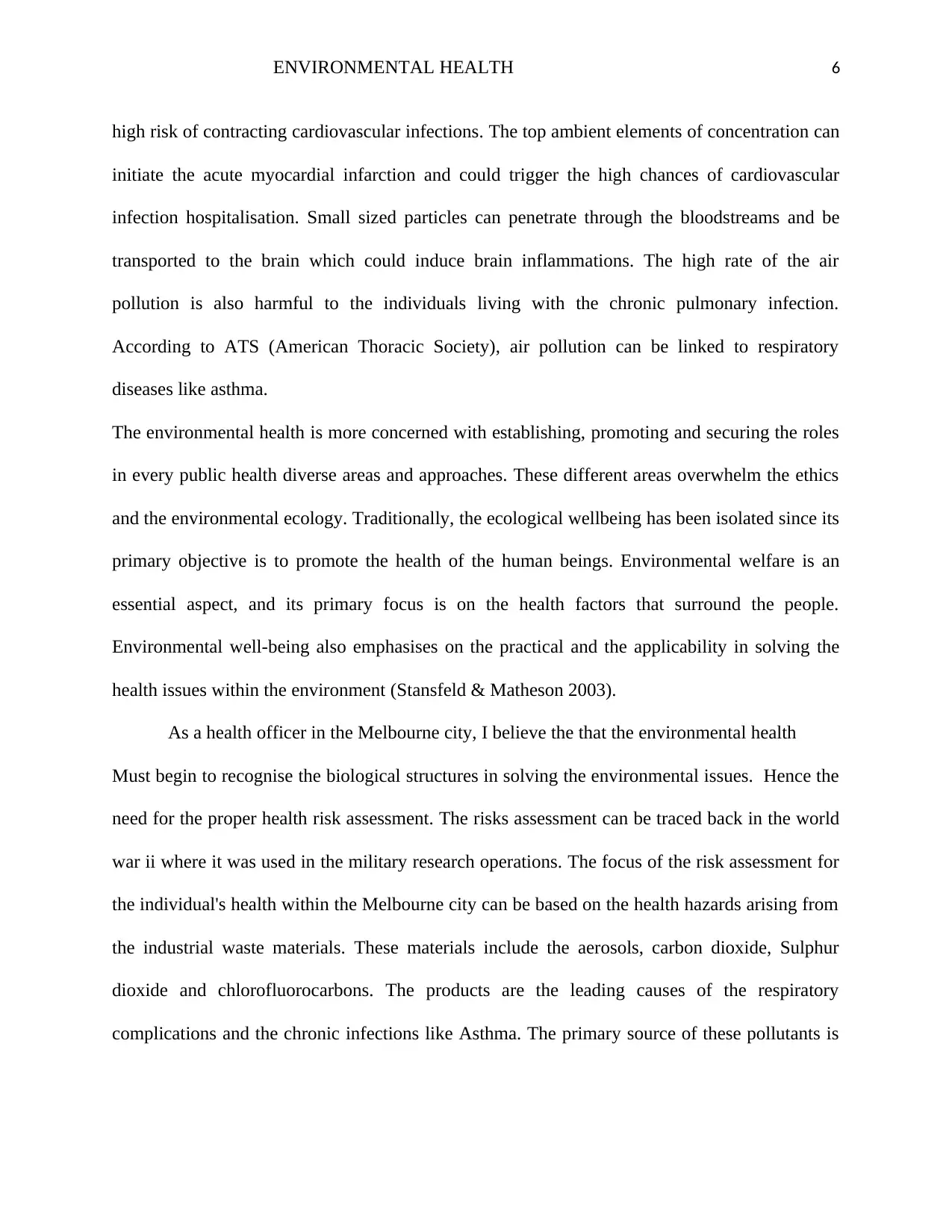
ENVIRONMENTAL HEALTH 6
high risk of contracting cardiovascular infections. The top ambient elements of concentration can
initiate the acute myocardial infarction and could trigger the high chances of cardiovascular
infection hospitalisation. Small sized particles can penetrate through the bloodstreams and be
transported to the brain which could induce brain inflammations. The high rate of the air
pollution is also harmful to the individuals living with the chronic pulmonary infection.
According to ATS (American Thoracic Society), air pollution can be linked to respiratory
diseases like asthma.
The environmental health is more concerned with establishing, promoting and securing the roles
in every public health diverse areas and approaches. These different areas overwhelm the ethics
and the environmental ecology. Traditionally, the ecological wellbeing has been isolated since its
primary objective is to promote the health of the human beings. Environmental welfare is an
essential aspect, and its primary focus is on the health factors that surround the people.
Environmental well-being also emphasises on the practical and the applicability in solving the
health issues within the environment (Stansfeld & Matheson 2003).
As a health officer in the Melbourne city, I believe the that the environmental health
Must begin to recognise the biological structures in solving the environmental issues. Hence the
need for the proper health risk assessment. The risks assessment can be traced back in the world
war ii where it was used in the military research operations. The focus of the risk assessment for
the individual's health within the Melbourne city can be based on the health hazards arising from
the industrial waste materials. These materials include the aerosols, carbon dioxide, Sulphur
dioxide and chlorofluorocarbons. The products are the leading causes of the respiratory
complications and the chronic infections like Asthma. The primary source of these pollutants is
high risk of contracting cardiovascular infections. The top ambient elements of concentration can
initiate the acute myocardial infarction and could trigger the high chances of cardiovascular
infection hospitalisation. Small sized particles can penetrate through the bloodstreams and be
transported to the brain which could induce brain inflammations. The high rate of the air
pollution is also harmful to the individuals living with the chronic pulmonary infection.
According to ATS (American Thoracic Society), air pollution can be linked to respiratory
diseases like asthma.
The environmental health is more concerned with establishing, promoting and securing the roles
in every public health diverse areas and approaches. These different areas overwhelm the ethics
and the environmental ecology. Traditionally, the ecological wellbeing has been isolated since its
primary objective is to promote the health of the human beings. Environmental welfare is an
essential aspect, and its primary focus is on the health factors that surround the people.
Environmental well-being also emphasises on the practical and the applicability in solving the
health issues within the environment (Stansfeld & Matheson 2003).
As a health officer in the Melbourne city, I believe the that the environmental health
Must begin to recognise the biological structures in solving the environmental issues. Hence the
need for the proper health risk assessment. The risks assessment can be traced back in the world
war ii where it was used in the military research operations. The focus of the risk assessment for
the individual's health within the Melbourne city can be based on the health hazards arising from
the industrial waste materials. These materials include the aerosols, carbon dioxide, Sulphur
dioxide and chlorofluorocarbons. The products are the leading causes of the respiratory
complications and the chronic infections like Asthma. The primary source of these pollutants is
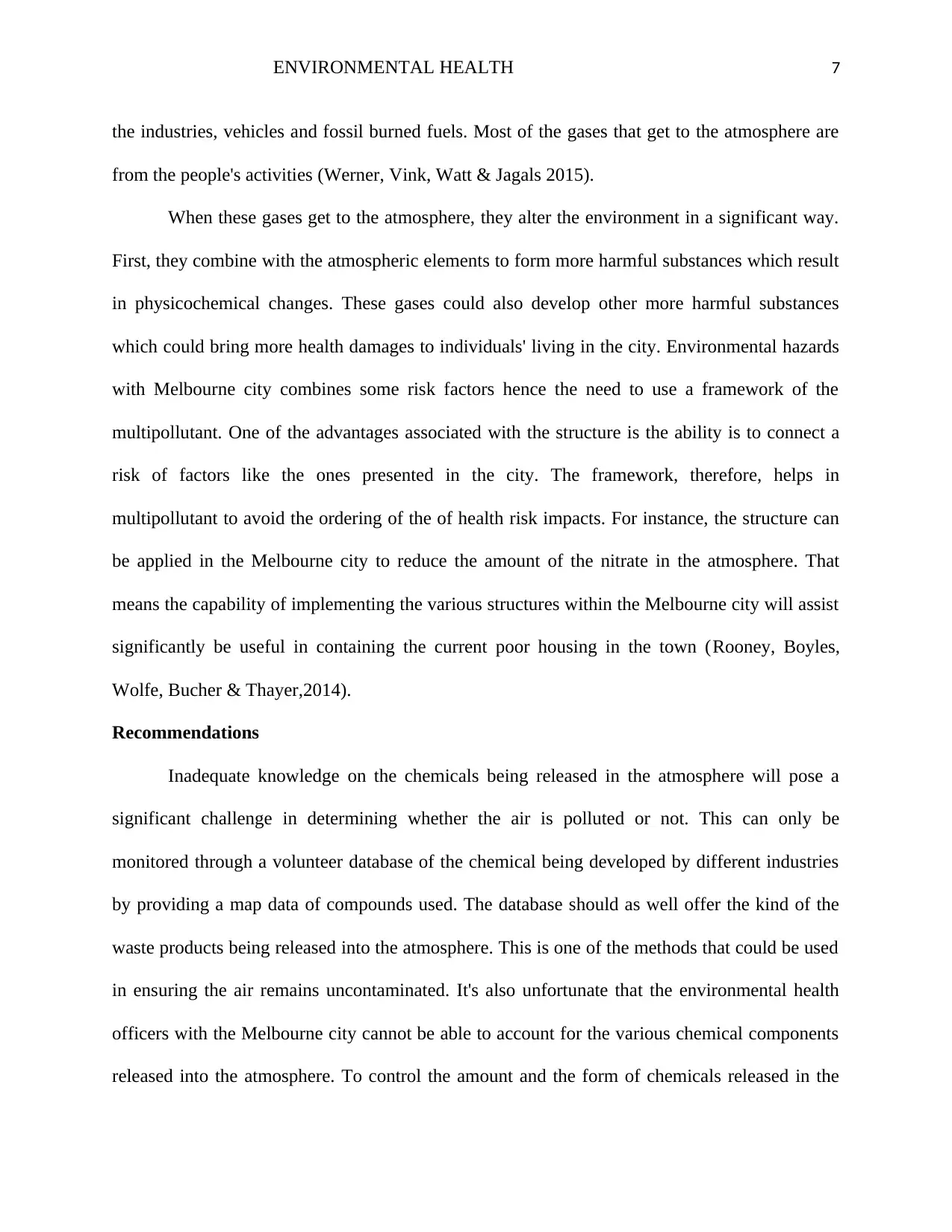
ENVIRONMENTAL HEALTH 7
the industries, vehicles and fossil burned fuels. Most of the gases that get to the atmosphere are
from the people's activities (Werner, Vink, Watt & Jagals 2015).
When these gases get to the atmosphere, they alter the environment in a significant way.
First, they combine with the atmospheric elements to form more harmful substances which result
in physicochemical changes. These gases could also develop other more harmful substances
which could bring more health damages to individuals' living in the city. Environmental hazards
with Melbourne city combines some risk factors hence the need to use a framework of the
multipollutant. One of the advantages associated with the structure is the ability is to connect a
risk of factors like the ones presented in the city. The framework, therefore, helps in
multipollutant to avoid the ordering of the of health risk impacts. For instance, the structure can
be applied in the Melbourne city to reduce the amount of the nitrate in the atmosphere. That
means the capability of implementing the various structures within the Melbourne city will assist
significantly be useful in containing the current poor housing in the town (Rooney, Boyles,
Wolfe, Bucher & Thayer,2014).
Recommendations
Inadequate knowledge on the chemicals being released in the atmosphere will pose a
significant challenge in determining whether the air is polluted or not. This can only be
monitored through a volunteer database of the chemical being developed by different industries
by providing a map data of compounds used. The database should as well offer the kind of the
waste products being released into the atmosphere. This is one of the methods that could be used
in ensuring the air remains uncontaminated. It's also unfortunate that the environmental health
officers with the Melbourne city cannot be able to account for the various chemical components
released into the atmosphere. To control the amount and the form of chemicals released in the
the industries, vehicles and fossil burned fuels. Most of the gases that get to the atmosphere are
from the people's activities (Werner, Vink, Watt & Jagals 2015).
When these gases get to the atmosphere, they alter the environment in a significant way.
First, they combine with the atmospheric elements to form more harmful substances which result
in physicochemical changes. These gases could also develop other more harmful substances
which could bring more health damages to individuals' living in the city. Environmental hazards
with Melbourne city combines some risk factors hence the need to use a framework of the
multipollutant. One of the advantages associated with the structure is the ability is to connect a
risk of factors like the ones presented in the city. The framework, therefore, helps in
multipollutant to avoid the ordering of the of health risk impacts. For instance, the structure can
be applied in the Melbourne city to reduce the amount of the nitrate in the atmosphere. That
means the capability of implementing the various structures within the Melbourne city will assist
significantly be useful in containing the current poor housing in the town (Rooney, Boyles,
Wolfe, Bucher & Thayer,2014).
Recommendations
Inadequate knowledge on the chemicals being released in the atmosphere will pose a
significant challenge in determining whether the air is polluted or not. This can only be
monitored through a volunteer database of the chemical being developed by different industries
by providing a map data of compounds used. The database should as well offer the kind of the
waste products being released into the atmosphere. This is one of the methods that could be used
in ensuring the air remains uncontaminated. It's also unfortunate that the environmental health
officers with the Melbourne city cannot be able to account for the various chemical components
released into the atmosphere. To control the amount and the form of chemicals released in the
Paraphrase This Document
Need a fresh take? Get an instant paraphrase of this document with our AI Paraphraser
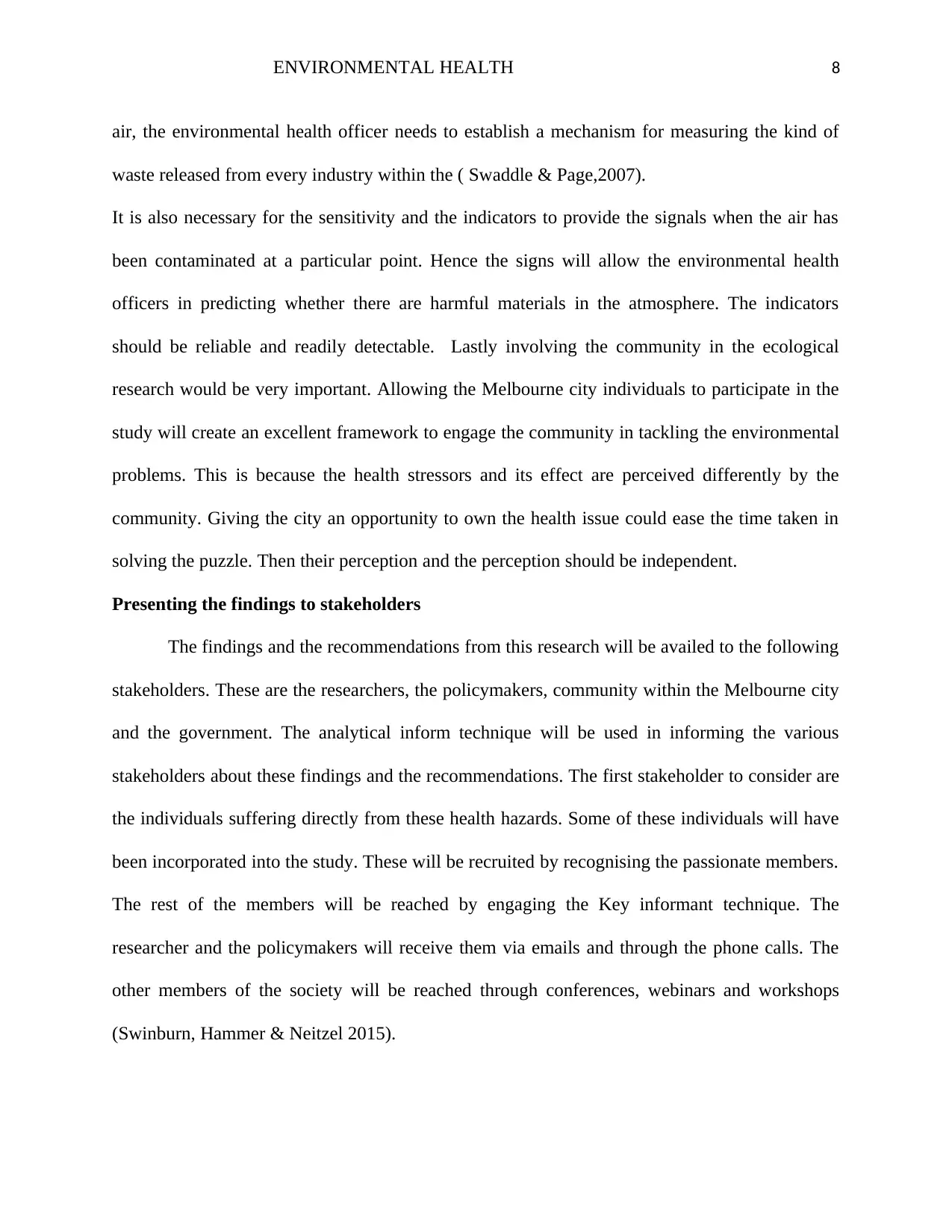
ENVIRONMENTAL HEALTH 8
air, the environmental health officer needs to establish a mechanism for measuring the kind of
waste released from every industry within the ( Swaddle & Page,2007).
It is also necessary for the sensitivity and the indicators to provide the signals when the air has
been contaminated at a particular point. Hence the signs will allow the environmental health
officers in predicting whether there are harmful materials in the atmosphere. The indicators
should be reliable and readily detectable. Lastly involving the community in the ecological
research would be very important. Allowing the Melbourne city individuals to participate in the
study will create an excellent framework to engage the community in tackling the environmental
problems. This is because the health stressors and its effect are perceived differently by the
community. Giving the city an opportunity to own the health issue could ease the time taken in
solving the puzzle. Then their perception and the perception should be independent.
Presenting the findings to stakeholders
The findings and the recommendations from this research will be availed to the following
stakeholders. These are the researchers, the policymakers, community within the Melbourne city
and the government. The analytical inform technique will be used in informing the various
stakeholders about these findings and the recommendations. The first stakeholder to consider are
the individuals suffering directly from these health hazards. Some of these individuals will have
been incorporated into the study. These will be recruited by recognising the passionate members.
The rest of the members will be reached by engaging the Key informant technique. The
researcher and the policymakers will receive them via emails and through the phone calls. The
other members of the society will be reached through conferences, webinars and workshops
(Swinburn, Hammer & Neitzel 2015).
air, the environmental health officer needs to establish a mechanism for measuring the kind of
waste released from every industry within the ( Swaddle & Page,2007).
It is also necessary for the sensitivity and the indicators to provide the signals when the air has
been contaminated at a particular point. Hence the signs will allow the environmental health
officers in predicting whether there are harmful materials in the atmosphere. The indicators
should be reliable and readily detectable. Lastly involving the community in the ecological
research would be very important. Allowing the Melbourne city individuals to participate in the
study will create an excellent framework to engage the community in tackling the environmental
problems. This is because the health stressors and its effect are perceived differently by the
community. Giving the city an opportunity to own the health issue could ease the time taken in
solving the puzzle. Then their perception and the perception should be independent.
Presenting the findings to stakeholders
The findings and the recommendations from this research will be availed to the following
stakeholders. These are the researchers, the policymakers, community within the Melbourne city
and the government. The analytical inform technique will be used in informing the various
stakeholders about these findings and the recommendations. The first stakeholder to consider are
the individuals suffering directly from these health hazards. Some of these individuals will have
been incorporated into the study. These will be recruited by recognising the passionate members.
The rest of the members will be reached by engaging the Key informant technique. The
researcher and the policymakers will receive them via emails and through the phone calls. The
other members of the society will be reached through conferences, webinars and workshops
(Swinburn, Hammer & Neitzel 2015).
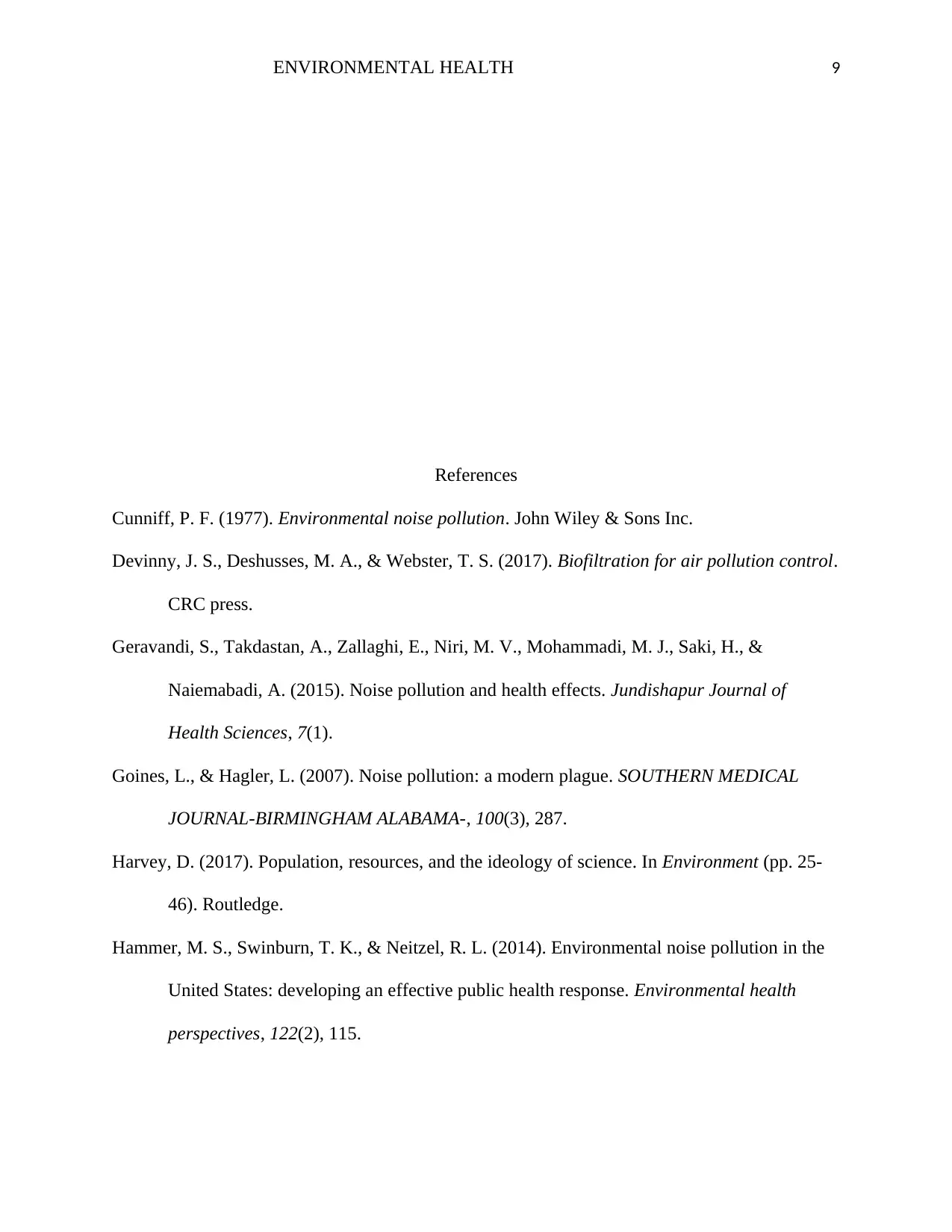
ENVIRONMENTAL HEALTH 9
References
Cunniff, P. F. (1977). Environmental noise pollution. John Wiley & Sons Inc.
Devinny, J. S., Deshusses, M. A., & Webster, T. S. (2017). Biofiltration for air pollution control.
CRC press.
Geravandi, S., Takdastan, A., Zallaghi, E., Niri, M. V., Mohammadi, M. J., Saki, H., &
Naiemabadi, A. (2015). Noise pollution and health effects. Jundishapur Journal of
Health Sciences, 7(1).
Goines, L., & Hagler, L. (2007). Noise pollution: a modern plague. SOUTHERN MEDICAL
JOURNAL-BIRMINGHAM ALABAMA-, 100(3), 287.
Harvey, D. (2017). Population, resources, and the ideology of science. In Environment (pp. 25-
46). Routledge.
Hammer, M. S., Swinburn, T. K., & Neitzel, R. L. (2014). Environmental noise pollution in the
United States: developing an effective public health response. Environmental health
perspectives, 122(2), 115.
References
Cunniff, P. F. (1977). Environmental noise pollution. John Wiley & Sons Inc.
Devinny, J. S., Deshusses, M. A., & Webster, T. S. (2017). Biofiltration for air pollution control.
CRC press.
Geravandi, S., Takdastan, A., Zallaghi, E., Niri, M. V., Mohammadi, M. J., Saki, H., &
Naiemabadi, A. (2015). Noise pollution and health effects. Jundishapur Journal of
Health Sciences, 7(1).
Goines, L., & Hagler, L. (2007). Noise pollution: a modern plague. SOUTHERN MEDICAL
JOURNAL-BIRMINGHAM ALABAMA-, 100(3), 287.
Harvey, D. (2017). Population, resources, and the ideology of science. In Environment (pp. 25-
46). Routledge.
Hammer, M. S., Swinburn, T. K., & Neitzel, R. L. (2014). Environmental noise pollution in the
United States: developing an effective public health response. Environmental health
perspectives, 122(2), 115.
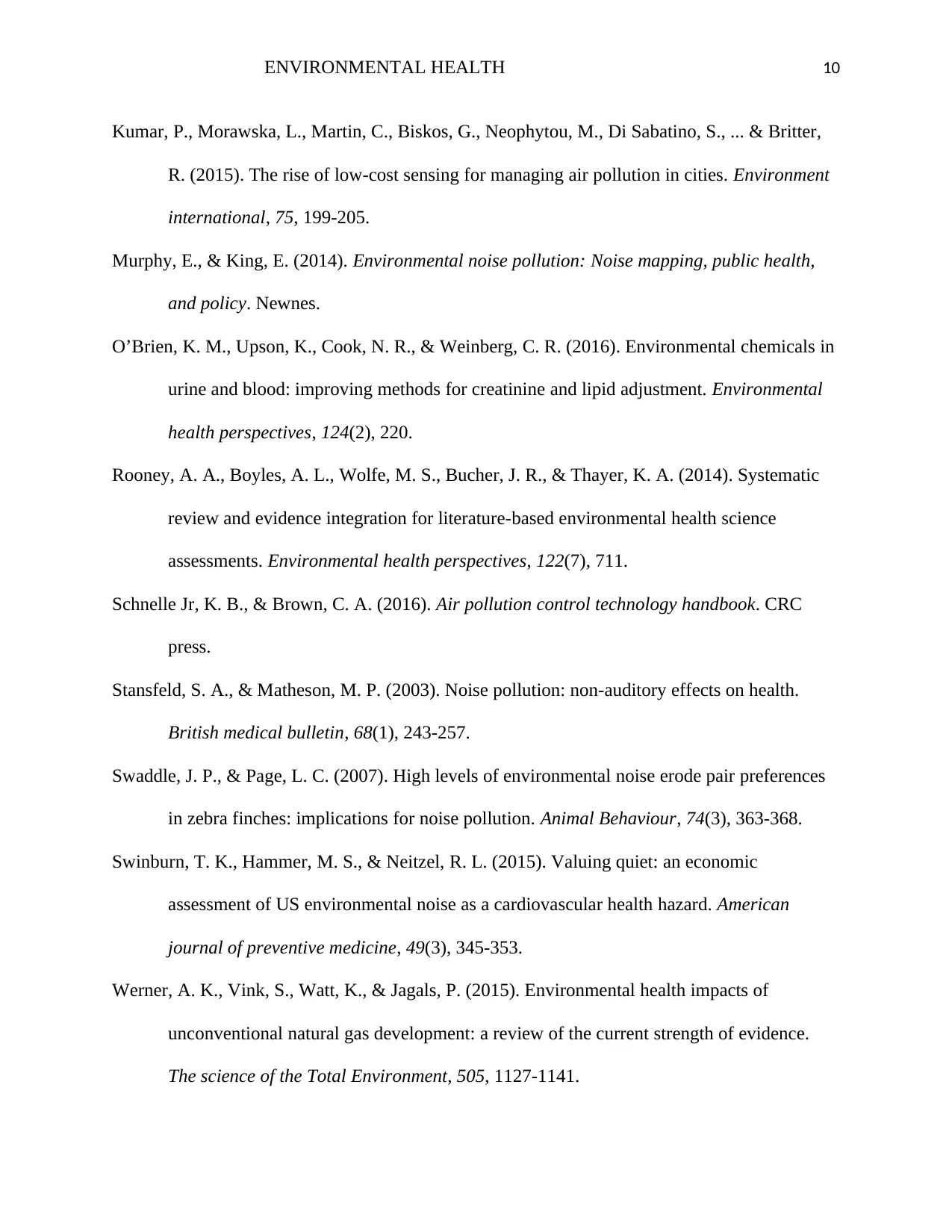
ENVIRONMENTAL HEALTH 10
Kumar, P., Morawska, L., Martin, C., Biskos, G., Neophytou, M., Di Sabatino, S., ... & Britter,
R. (2015). The rise of low-cost sensing for managing air pollution in cities. Environment
international, 75, 199-205.
Murphy, E., & King, E. (2014). Environmental noise pollution: Noise mapping, public health,
and policy. Newnes.
O’Brien, K. M., Upson, K., Cook, N. R., & Weinberg, C. R. (2016). Environmental chemicals in
urine and blood: improving methods for creatinine and lipid adjustment. Environmental
health perspectives, 124(2), 220.
Rooney, A. A., Boyles, A. L., Wolfe, M. S., Bucher, J. R., & Thayer, K. A. (2014). Systematic
review and evidence integration for literature-based environmental health science
assessments. Environmental health perspectives, 122(7), 711.
Schnelle Jr, K. B., & Brown, C. A. (2016). Air pollution control technology handbook. CRC
press.
Stansfeld, S. A., & Matheson, M. P. (2003). Noise pollution: non-auditory effects on health.
British medical bulletin, 68(1), 243-257.
Swaddle, J. P., & Page, L. C. (2007). High levels of environmental noise erode pair preferences
in zebra finches: implications for noise pollution. Animal Behaviour, 74(3), 363-368.
Swinburn, T. K., Hammer, M. S., & Neitzel, R. L. (2015). Valuing quiet: an economic
assessment of US environmental noise as a cardiovascular health hazard. American
journal of preventive medicine, 49(3), 345-353.
Werner, A. K., Vink, S., Watt, K., & Jagals, P. (2015). Environmental health impacts of
unconventional natural gas development: a review of the current strength of evidence.
The science of the Total Environment, 505, 1127-1141.
Kumar, P., Morawska, L., Martin, C., Biskos, G., Neophytou, M., Di Sabatino, S., ... & Britter,
R. (2015). The rise of low-cost sensing for managing air pollution in cities. Environment
international, 75, 199-205.
Murphy, E., & King, E. (2014). Environmental noise pollution: Noise mapping, public health,
and policy. Newnes.
O’Brien, K. M., Upson, K., Cook, N. R., & Weinberg, C. R. (2016). Environmental chemicals in
urine and blood: improving methods for creatinine and lipid adjustment. Environmental
health perspectives, 124(2), 220.
Rooney, A. A., Boyles, A. L., Wolfe, M. S., Bucher, J. R., & Thayer, K. A. (2014). Systematic
review and evidence integration for literature-based environmental health science
assessments. Environmental health perspectives, 122(7), 711.
Schnelle Jr, K. B., & Brown, C. A. (2016). Air pollution control technology handbook. CRC
press.
Stansfeld, S. A., & Matheson, M. P. (2003). Noise pollution: non-auditory effects on health.
British medical bulletin, 68(1), 243-257.
Swaddle, J. P., & Page, L. C. (2007). High levels of environmental noise erode pair preferences
in zebra finches: implications for noise pollution. Animal Behaviour, 74(3), 363-368.
Swinburn, T. K., Hammer, M. S., & Neitzel, R. L. (2015). Valuing quiet: an economic
assessment of US environmental noise as a cardiovascular health hazard. American
journal of preventive medicine, 49(3), 345-353.
Werner, A. K., Vink, S., Watt, K., & Jagals, P. (2015). Environmental health impacts of
unconventional natural gas development: a review of the current strength of evidence.
The science of the Total Environment, 505, 1127-1141.
Secure Best Marks with AI Grader
Need help grading? Try our AI Grader for instant feedback on your assignments.
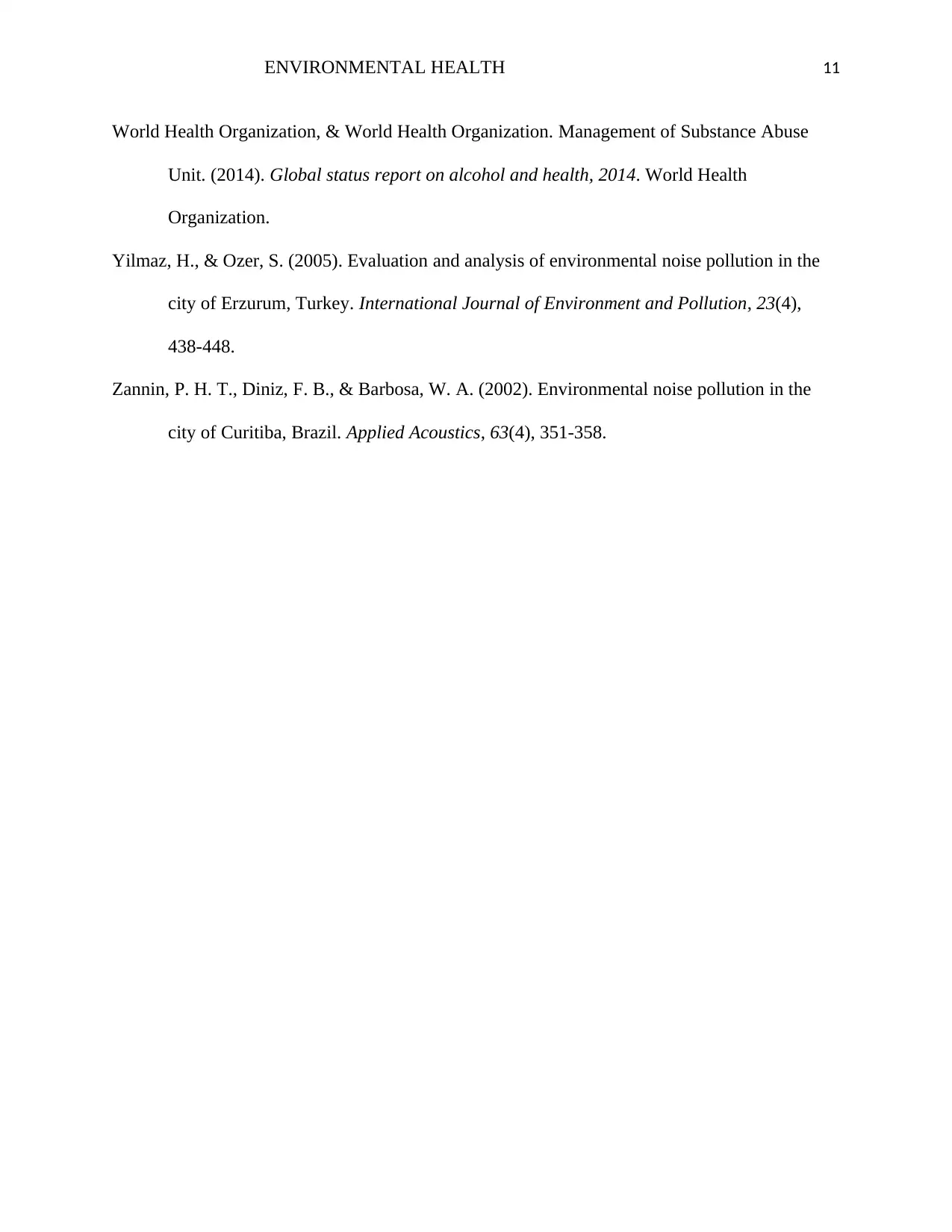
ENVIRONMENTAL HEALTH 11
World Health Organization, & World Health Organization. Management of Substance Abuse
Unit. (2014). Global status report on alcohol and health, 2014. World Health
Organization.
Yilmaz, H., & Ozer, S. (2005). Evaluation and analysis of environmental noise pollution in the
city of Erzurum, Turkey. International Journal of Environment and Pollution, 23(4),
438-448.
Zannin, P. H. T., Diniz, F. B., & Barbosa, W. A. (2002). Environmental noise pollution in the
city of Curitiba, Brazil. Applied Acoustics, 63(4), 351-358.
World Health Organization, & World Health Organization. Management of Substance Abuse
Unit. (2014). Global status report on alcohol and health, 2014. World Health
Organization.
Yilmaz, H., & Ozer, S. (2005). Evaluation and analysis of environmental noise pollution in the
city of Erzurum, Turkey. International Journal of Environment and Pollution, 23(4),
438-448.
Zannin, P. H. T., Diniz, F. B., & Barbosa, W. A. (2002). Environmental noise pollution in the
city of Curitiba, Brazil. Applied Acoustics, 63(4), 351-358.
1 out of 11
Related Documents
Your All-in-One AI-Powered Toolkit for Academic Success.
+13062052269
info@desklib.com
Available 24*7 on WhatsApp / Email
![[object Object]](/_next/static/media/star-bottom.7253800d.svg)
Unlock your academic potential
© 2024 | Zucol Services PVT LTD | All rights reserved.





